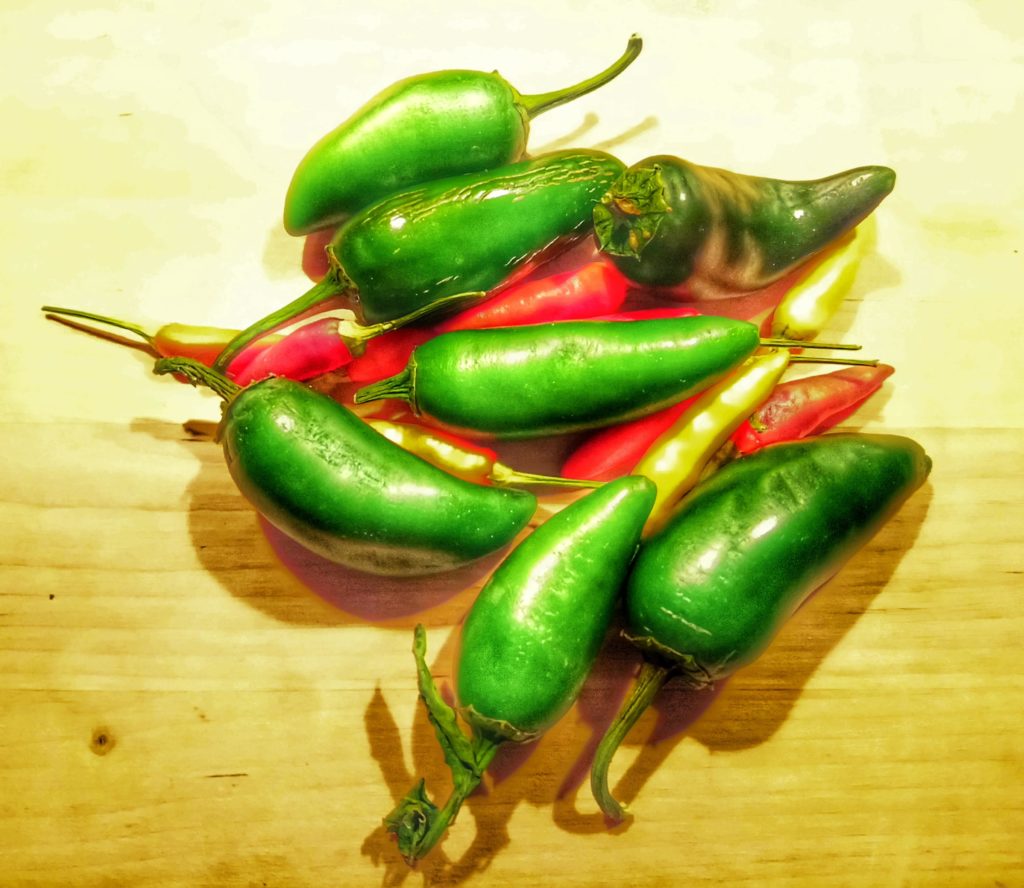You can pickle a peck, eat them raw, braise them, fry them, can, jelly or chop them into tiny bits to bring a little zest or sweetness to a home cooked meal. Peppers are an enticing and diverse fruit that are a global household staple and commonly associated with ‘old world’ cuisine. I will explore with you the native origin of peppers, share some growing tips and delve into hotter than heck varieties.
Peppers are determined to be in the same plant family (Solanaceae) as tomato and potato. Like their cousins, peppers are New World fruits with origins in Central and South America and estimated to have been domesticated thousands of years ago. Columbus voyages brought peppers back to Europe, introducing a piquant alternative to familiar black pepper and setting in motion distribution of a plant that would make a significant cultural global impact for decades to come that includes Indian, Thai, Korean, Chinese, African and Latin American cuisine. According to an article in American Society for Horticulture Science, “Asia currently contributes approximately 65% of the global production of pepper, whereas the Americas, Europe, and Africa each contribute 13.3%, 11.9%, and 10.1%, respectively” (February 21, 2019), making Capsicum a major vegetable and spice crop worldwide.
Growing peppers can be a rewarding gardening experience. Like most vegetables, peppers require sandy loam soil with good drainage and a pH measuring 6 to 7.5. Fortunately for Brazoria County gardeners, peppers can tolerate heavier clay soils. Peppers are classified as a warm season crop, producing fruit in warm daytime temperatures up to mid 90-degrees and relatively cool nights up to the mid-70s. We culturally treat this group as annual plants because of their sensitivity to cold winter temperature.\
Excessive high temperatures will reduce fruit size and may cause bloom drop; you may begin to see a reduction in fruit production at this time of year due to increased and longer duration summers temps. References for growing will instruct to provide full sun for peppers, at minimum 6 hours of sunlight per day. However, higher irradiance increases the chance of sunscald on your fruit. The overall canopy of your pepper may be dense enough to provide some shade for developing fruit and reduce incidence of sunscald at this time of year. You may have to resort to make-shift tents made with shade cloth to reduce sunscald if your pepper plants are not doing the job. While we focus planting peppers like jalapeño when the soil warms in spring (March to April) and then begin to harvest around June, you can plant pepper transplants in late July to August for an outstanding October harvest.
Most of the domesticated peppers we use are botanically known as Capsicum annuum. This is a very diverse species that come in all shapes and sizes: mild and sweet bell peppers, hot and spicy jalapeños and varieties with distinctive flavors like New Mexico hybrids and cayenne pepper. C. annuum is one of four major species of pepper in cultivation that include Capsicum chinense, which produces some of the hottest peppers like Scotch Bonnet, Trinidad Scorpion, Bhut Jolokia and Carolina Reaper. A measurement called the Scoville Scale is used to determine the concentration of capsaicin (compound giving hot peppers their spicy kick and reported as Scoville Heat Units, or SHU) in each variety of peppers. The testing method and scale, developed by American pharmacist Wilbur Scoville in 1912, involved taking an exact weight of dried pepper dissolved in alcohol to extract the compounds, then diluted in a measured solution of sugar water. The lucky taste testers would then sample each concoction, increasing the amount of sugar in solution until a majority of the panelists could no longer detect heat in dilution. Needless to say, results would vary widely between labs due to the subjectivity of the experiment. Current testing methods are more precise, using liquid chromatography to determine pungency. The winner for hottest pepper: Carolina Reaper, measured on average over 1 million SHU. In comparison, jalapeños are lowest heat and average at 4 thousand SHU.
Regardless of the kind of pepper you choose to consume, keep in mind that peppers produce Vitamin A and C and minerals necessary for our health. Informing you, dear reader, of the benefits of using these nutritious fruits and connecting agricultural production information is part of Texas A&M AgriLife Extension’s Path to Plate program, an unbiased resource and research-based information to help consumers make informed decisions when it comes to agriculture and your health.
Do you have a favorite hot or sweet pepper? I invite you to share your ideas and successes in your garden by browsing online to my Facebook webpage: https://www.facebook.com/horticulturiststephenb, as well as keeping up with programs and activities promoted from Brazoria County AgriLife Extension. Stay cool, Brazoria County, and I’ll see you in the garden!

